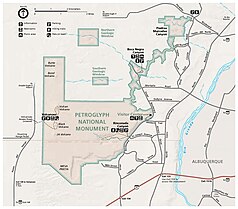Petroglyph National Monument
| Petroglyph National Monument | ||
|---|---|---|
| Prehistoric Indian rock carvings | ||
|
|
||
| Location: | New Mexico , United States | |
| Specialty: | Semi-desert rock art on the outskirts of Albuquerque | |
| Next city: | Albuquerque | |
| Surface: | 29.3 km² | |
| Founding: | June 27, 1990 | |
| Visitors: | 102623 (2005) | |
Petroglyph National Monument is a small national monument- type protected area in the US state of New Mexico . In addition to the volcanic landscape and semi-desert vegetation, it preserves several ruins of prehistoric Indian settlements from forerunners of the Pueblo culture and around 20,000 rock carvings , mostly by the prehistoric Indians, but also by Spanish settlers and early white Americans.
The area was designated as a National Monument in 1990 and administered by the National Park Service together with the Albuquerque City Council.
description
On the western outskirts of Albuquerque, the cliffs of the West Mesa rise from the valley of the Rio Grande , a layer of predominantly volcanic basalt . The protected area comprises part of the plateau, several canyons in which the rock carvings are mostly located, and in the far west three small cinder cone volcanoes.
Around 90% of the rock carvings come from the prehistoric Indians, from which the Pueblo culture emerged. They were made between the years 1300 and around 1600. The first still through direct hits of a stone on the rocks covered with dark patina . Later, a hammer- and- chisel technique was developed with suitably shaped stones that allowed details to be worked out with much greater control. In addition to human figures and body parts such as hands and feet in particular, mostly animals were depicted. There are also geometrical figures such as spirals and stars . Other carvings were made by Spanish immigrants in the 17th and 18th centuries, and some by white American settlers in the 19th century.
The Indian petroglyphs have, according to the modern Pueblo Indians rich culture elle and cult ical meanings that are only partially mediated to outsiders.
Web links
- National Park Service: Petroglyph National Monument (official site; English)
- YouTube: Petroglyph National Monument in Albuquerque - Video: Running time 4:07 minutes, produced by the Albuquerque Convention and Visitors Bureau


